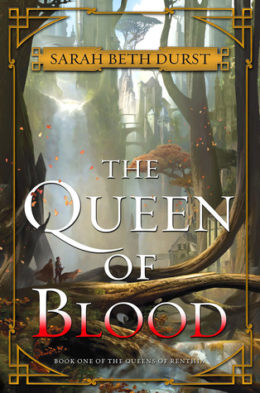Autumn only ever helps me forget the death of the earth. As green withers to brown and wind sharpens into something like winter, it’s easy to think of the dying earth as an annual ritual rather than a looming (and more permanent) scientific reality. And where the turn in scifi towards eco-futurism, solarpunk, and dystopian climate disasters is a constant reminder of humanity’s relationship to that countdown, I tend to consider the high fantasy genre to hold a more romantic perspective, one that invokes the cyclical nature of the seasons. Whether it’s magic growing out of humanity’s connection to earth, or an abomination against it, the genre so often yearns for equilibrium and for a pre-modern relationship to nature.
It’s not an overarching theme, of course, but often the secondary worlds that break that mold are doing it so deliberately that we can’t help but sit up and take notice. Last year, one of those novels was Uprooted, by Naomi Novik. This fall, while trees are dying and the air is quickening, the exception to watch for is The Queen of Blood, by Sarah Beth Durst. Nature in this world is anything but benevolent. The bond it has formed with humanity is anything but equal. Nature, in Renthia, is honestly a bit terrifying.
In Renthia, the queen maintains a tenuous peace between her subjects and the nature spirits that share their land. These spirits—fire, ice, water, air, earth, and tree—create and destroy. Without them, there would be no Renthia to speak of, and yet without the queen, the spirits wreak havoc on human communities, destroying homes and devouring their inhabitants without mercy. And so young girls aspire to be her, train as her heirs and as her champions, so that they can someday protect Renthia by controlling its spirits. Queen of Blood’s protagonist is, in this way, like any other Renthian girl with a knack for magic. What makes Daleina different is that she knows the cost of that magic’s failure. When she was ten years old, Daleina was helpless to protect her village when the spirits laid it to waste. She spends the rest of her life striving to never feel that helpless again.
Meanwhile Ven, a disgraced former champion to Queen Fara, is on the move to save villages like Daleina’s. The spirits are attacking more frequently and more violently. It’s almost like the Queen has lost control of them. However Ven had a—shall we say—intimate relationship with Fara, and refuses to believe it. Even though he’s disgraced, he does everything he can to protect Renthia and its queen, even if that means betraying them in the process.
The bulk of Queen of Blood follows Daleina’s training—from her time as a student at a prestigious magic school, to her fated meeting with Ven. Like any good heroine, she’s not perfect. In fact, she’s not even good at magic itself, just strategy and leadership, stubbornness and wilderness skills. Her classmates, in another story, might belittle or bully her for this, but the female friendships in Queen of Blood are its greatest gift to its readers. Even Merecot, set up as the Queen-Bee-Head-Cheerleader-type, has a nuanced relationship with Daleina, one of mutual respect and teasing (or flirting, if you’re a wishful thinker). These relationships, as well as those between Daleina and her family, and between Ven and Fara, drive this novel perhaps even more than its initial concept.
Its initial concept, though, of a natural world beset by cruelty, is strong, and it’s made stronger by its sweeping, gorgeous settings. Renthia is, after all, a kingdom based in the trees, connected by bridges and ropes and buildings that soar into the heights of the forests’ canopies. And so when the nature spirits rebel, humanity feels it all the more acutely; when humanity falls—whether literally or metaphorically—they have a long path to the ground. More than anything, I look forward to Queen of Blood’s sequel as a map of that fall. The nature of the original pact between humans and spirits is unclear in this first novel, and will make or break a great many of the themes it’s laid out.
The only thing that kept me from loving (rather than liking) this book was the writing itself. Durst has a tendency to dip into showy dialogue—quippy one-liners being the silliest culprit—and transparent descriptions of characters’ thoughts and emotions. These changes in tone, subtlety, and emotional realism seemed at times like shifts between an adult and a young adult novel, or perhaps between a drama and a comedy. But while this nebulous audience shifting took me out of the action more than once, the plot was compelling enough that I never stayed out for long. Daleina’s exploits were far too exciting not to follow, and the danger posed to her and her friends was real and present at every turn. I’m excited for Queen of Blood’s sequel, regardless of its prose. Durst knows how to move her audience and rattle the earth, and that’s all I can really ask for.
The Queen of Blood is available now from HarperCollins.
Emily Nordling is a library assistant and perpetual student in Chicago, IL.










